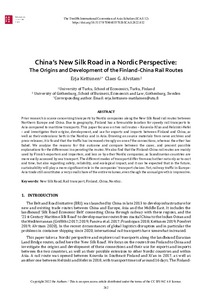China’s New Silk Road in a Nordic Perspective: The Origins and Development of the Finland-China Rail Routes
Alvstam Claes G.; Kettunen Erja
https://urn.fi/URN:NBN:fi-fe2022081155074
Tiivistelmä
Prior research is scarce concerning transports by Nordic companies along the New Silk Road rail routes between Northern Europe and China. Due to geography, Finland has a favourable location for speedy rail transports to Asia compared to maritime transports. This paper focuses on two rail routes – Kouvola-Xi’an and Helsinki-Hefei – and investigates their origins, development, and use for exports and imports between Finland and China, as well as their extensions both in the Nordics and in Asia. Drawing on source materials from news archives and press releases, it is found that the traffic has increased strongly on one of the connections, whereas the other has faded. We analyze the reasons for this outcome and compare between the cases, and present possible explanations for the differences in operating the routes. We also find that the Finland-China rail routes are mainly used by Finnish exporters and importers, and less so by other Nordic companies, as Scandinavian countries are more easily accessed by sea transport. The different modes of transport differ from each other not only as to cost and time, but also regarding safety, reliability, and ecological impact, and it can be expected that in the future, sustainability will play a more significant role in the companies’ transport choices. Yet, railway traffic in Europe-Asia trade still constitutes a very small share of the entire volumes, even though the annual growth is impressive.
Kokoelmat
- Rinnakkaistallenteet [19207]
